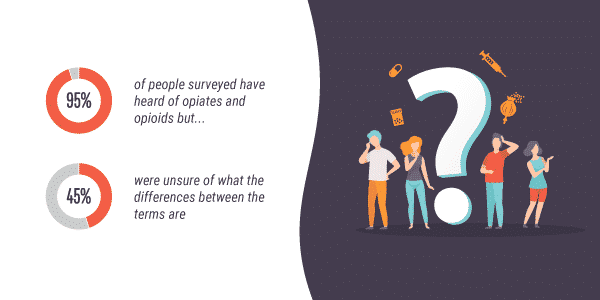Though people may believe opioids and opiates are the same, there are slight differences. Knowing the differences can help people better understand the opioid epidemic.
Theopioid crisisin the United States is a significant, nation-wide problem. The issue is complicated, but it becomes more challenging when so many people do not fully understand what these drugs are. Many people only have a vague idea of what an opioid is or how it compares to an opiate.
According to recent polling conducted by The Recovery Village, out of 400 people surveyed, more than 95% have heard of opiates and opioids but 45% were unsure of what the differences between the terms are. Though organizations like theNational Institute on Drug Abuseand theCenters for Disease Control and Preventionhave begun to use the terms interchangeably or have abandoned the term opiate, learning the difference between opioids vs. opiates may help clarify the differences between the two.
Article at a Glance:
- The term “opioid” refers to all substances (natural or synthetic) that engage the brain’s opioid receptors
- Opiates are naturally-occurring opioids
- The brain cannot distinguish between opiates and opioids
- Opioids and opiates have the power to produce a variety of physical and psychological effects

What Is an Opioid?
Anopioidis any substance that creates an impact on the opioid receptors in the brain. Once the opioid attaches to the receptors, the substances can trigger desirable effects including:
- A euphoric high
- A lower sensation of pain
- Less coughing
- Reduced risk of diarrhea
Every “Opioid” substance sparks these effects in the brain, regardless of whether the drug is:
Treatment Can Be Life Changing. Reach out today.
Whether you are struggling with addiction, mental health or both, our expert team is here to guide you every step of the way. Don’t wait— reach out today to take the first step toward taking control of your life.
- A naturally occurring substance
- A semi-synthetic substance made in a laboratory from natural products
- A fully-synthetic substance completely formulated in a laboratory
Opioids come in a wide range of strengths and forms. They may be pills, powders or liquids that people ingest by swallowing, snorting, smoking or injecting. They may be relatively weak or potent enough to kill an elephant easily.
Not only doopioids affect the brain, but they can affect the body as well. Someone using an opioid may feel:
- Sleepy
- Confused
- Nauseous
- Constipated
- Slowed or labored breathing
What Is an Opiate?
Opiates are a type of opioid. Opiates are opioids that are found in thepoppy plantor made from a substance found in the poppy plant.
All opiates are opioids, but not all opioids are opiates. If any aspect of a drug is synthetic, the drug is not an opiate.
Whether the substance is an opioid or an opiate, the brain and the body react in similar ways. Opiates, like opioids, produce changes to the mind and body of the person who consumes it.
Main Differences Between Opioid and Opiates
As mentioned, the most significant difference that separatesopioids from opiatesis the origin of the substance. Does the substance exist naturally? Then it is an opiate and therefore, also an opioid. Does any part of the substance originate in a laboratory? Then it is not an opiate and is only an opioid.
There can be confusion with substances likeheroin. In fact, heroin is sometimes mistakenly referred to as an opiate. Heroin does not occur naturally, but it is created from morphine, which does occur naturally. So heroin is an opioid, but its parent drug, morphine, is an opiate.
People may argue that using both terms only creates misperceptions of the substances. According to The Recovery Village poll, about 54% of respondents correctly identifiedcodeineand morphine as opioids. When asked about opiates, only 39% listed codeine and 34% morphine, even though these are both technically opiates.
Examples of Opioids and Opiates
Many substances are classified as opiates and opioids. Some of these substances are familiar to many people, likemorphineor heroin, but some substances are less common to hear about, like pethidine or thebaine. Becoming familiar with the names and being able to classify some of the more common substances can be helpful to someone looking to understand the differences between the two.
Opioids
All substances that activate the opioid receptors are opioids, but the drugs that exclusively opioids include:
- Fentanyl
- Meperidine
- Levorphanol
- Methadone
- Tramadol
- Dextropropoxyphene
- Heroin
- Hydromorphone
- Hydrocodone
- Oxycodone
These synthetic or semi-synthetic drugs include manycommonly prescribed painkillers. They are also typically potent and contribute to the high rates ofopioid overdoses.
Opiates
Opiates can be prescription or illicit. Several frequently used opiates are:
- Morphine
- Codeine
- Thebaine
If you struggle with an addiction to opioids,contact The Recovery Villageto speak with a representative about how personalized addiction treatment can address your addiction and anyco-occurring mental health disorders. You deserve a healthier future. Call today.








